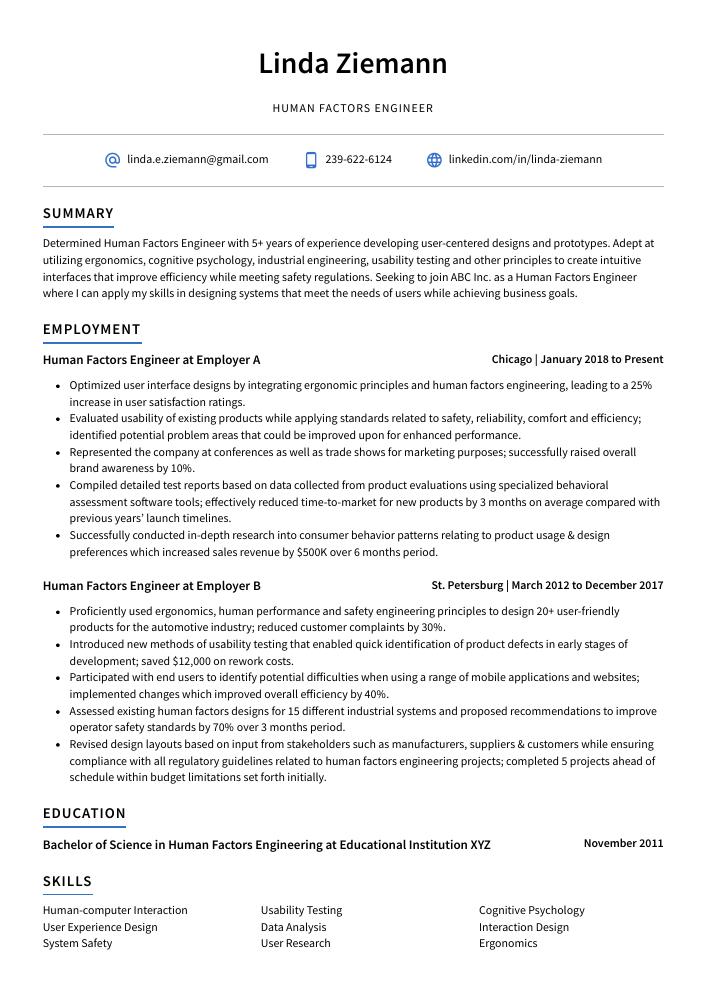Human Factors Engineer Resume Guide
Human Factors Engineers use their knowledge of psychology and engineering to design systems, products, and processes that are easy for people to use. They analyze how humans interact with machines, tools or other objects in order to make them safer, more efficient and comfortable. They also research human behavior patterns in order to develop better user interfaces.
You possess the skills and knowledge to tackle any human factors engineering challenge. But employers are unaware of your potential, so you need to write a standout resume that highlights your experience in this field.
This guide will walk you through the entire process of creating a top-notch resume. We first show you a complete example and then break down what each resume section should look like.
Table of Contents
The guide is divided into sections for your convenience. You can read it from beginning to end or use the table of contents below to jump to a specific part.
Human Factors Engineer Resume Sample
Linda Ziemann
Human Factors Engineer
[email protected]
239-622-6124
linkedin.com/in/linda-ziemann
Summary
Determined Human Factors Engineer with 5+ years of experience developing user-centered designs and prototypes. Adept at utilizing ergonomics, cognitive psychology, industrial engineering, usability testing and other principles to create intuitive interfaces that improve efficiency while meeting safety regulations. Seeking to join ABC Inc. as a Human Factors Engineer where I can apply my skills in designing systems that meet the needs of users while achieving business goals.
Experience
Human Factors Engineer, Employer A
Chicago, Jan 2018 – Present
- Optimized user interface designs by integrating ergonomic principles and human factors engineering, leading to a 25% increase in user satisfaction ratings.
- Evaluated usability of existing products while applying standards related to safety, reliability, comfort and efficiency; identified potential problem areas that could be improved upon for enhanced performance.
- Represented the company at conferences as well as trade shows for marketing purposes; successfully raised overall brand awareness by 10%.
- Compiled detailed test reports based on data collected from product evaluations using specialized behavioral assessment software tools; effectively reduced time-to-market for new products by 3 months on average compared with previous years’ launch timelines.
- Successfully conducted in-depth research into consumer behavior patterns relating to product usage & design preferences which increased sales revenue by $500K over 6 months period.
Human Factors Engineer, Employer B
St. Petersburg, Mar 2012 – Dec 2017
- Proficiently used ergonomics, human performance and safety engineering principles to design 20+ user-friendly products for the automotive industry; reduced customer complaints by 30%.
- Introduced new methods of usability testing that enabled quick identification of product defects in early stages of development; saved $12,000 on rework costs.
- Participated with end users to identify potential difficulties when using a range of mobile applications and websites; implemented changes which improved overall efficiency by 40%.
- Assessed existing human factors designs for 15 different industrial systems and proposed recommendations to improve operator safety standards by 70% over 3 months period.
- Revised design layouts based on input from stakeholders such as manufacturers, suppliers & customers while ensuring compliance with all regulatory guidelines related to human factors engineering projects; completed 5 projects ahead of schedule within budget limitations set forth initially.
Skills
- Human-computer Interaction
- Usability Testing
- Cognitive Psychology
- User Experience Design
- Data Analysis
- Interaction Design
- System Safety
- User Research
- Ergonomics
Education
Bachelor of Science in Human Factors Engineering
Educational Institution XYZ
Nov 2011
Certifications
Certified Professional Ergonomist (CPE)
Board of
May 2017
1. Summary / Objective
Your resume summary should provide the hiring manager with a snapshot of your qualifications and experience as a human factors engineer. Include details such as the ergonomic design principles you have implemented, any awards or certifications you possess, and how your work has improved user experiences in past roles. Additionally, mention any research projects or publications that demonstrate your commitment to staying up-to-date on industry trends.
Below are some resume summary examples:
Hard-working, detail-oriented human factors engineer with 4+ years of experience in product design and development. Seeking to leverage my expertise in ergonomics, user interface design, usability testing, and safety engineering for ABC Company. At XYZ Corporation implemented a successful redesign process that improved the customer satisfaction rate by 22%. Proven track record of creating innovative solutions that meet industry standards while surpassing user expectations.
Dependable human factors engineer with 5+ years of experience in the automotive industry. Experienced in developing and implementing systems to improve efficiency and safety for human-machine interactions. At XYZ, designed ergonomic engineering solutions that increased productivity by 20%. Recognized for successfully integrating physical user interface design into existing products, resulting in an increase of 40% customer satisfaction ratings.
Driven Human Factors Engineer with 7+ years of experience designing and developing products for the healthcare industry. Skilled in using ergonomic principles to enhance user safety, comfort and performance on medical devices. At XYZ Inc., developed a new product line that increased efficiency by 20%, resulting in cost savings of $2M per year. Proven ability to collaborate cross-functionally and lead successful projects from concept to launch.
Energetic human factors engineer with 7+ years of experience in the design, development, and testing of products to maximize user safety. Skilled in designing innovative systems that combine ergonomics principles with human-machine interfaces. At ABC Corporation, designed a new interface for an industrial machine that decreased incidents by 50%. Seeking to join XYZ Company to continue improving user experiences through well-crafted designs.
Accomplished human factors engineer with 9+ years of experience in UX design, usability testing, and ergonomics. Specialize in creating user-friendly products that are both attractive and highly functional. Successfully improved product efficiency by up to 25% while reducing customer complaints by 15%. Looking to join ABC Tech as a human factors engineer where I can utilize my skillset to develop innovative solutions for their clients.
Committed human factors engineer with 6+ years of experience in designing and developing products for the healthcare industry. Skilled at conducting usability tests, analyzing user behavior data, and creating prototypes to ensure compliance with ergonomic standards. At XYZ Corporation, conducted a successful end-to-end redesign of an existing medical device which resulted in 10% improvement in patient safety outcomes.
Enthusiastic and results-oriented human factors engineer with 5+ years of experience in UX/UI design, usability testing, and user-centered product development. Proven track record for creating efficient designs that drive engagement and lead to greater customer satisfaction. Skilled at collaborating with cross-functional teams to develop innovative solutions tailored specifically to the needs of users.
Skilled human factors engineer with 5+ years of experience providing guidance on product design, usability testing, and safety protocols. Proven track record in identifying user needs and developing strategies to improve the overall customer experience. Seeking to leverage my research-driven approach as a human factors engineer for ABC Technologies and drive meaningful innovation.
2. Experience / Employment
For the experience section, you’ll want to provide details on your employment history. This should be written in reverse chronological order, meaning the most recent job is listed first.
Stick to bullet points when writing this section; it makes it easier for the reader to take in what you have to say quickly and efficiently. When talking about what you did, make sure that each point contains detail and quantifiable results achieved if possible.
For example, instead of saying “Conducted ergonomic studies,” you could say “Performed detailed ergonomic assessments on 10+ workers at a manufacturing plant resulting in improved productivity by 15%.”
To write effective bullet points, begin with a strong verb or adverb. Industry specific verbs to use are:
- Designed
- Analyzed
- Evaluated
- Optimized
- Investigated
- Implemented
- Facilitated
- Monitored
- Researched
- Assessed
- Developed
- Programmed
- Tested
- Documented
- Troubleshot
Other general verbs you can use are:
- Achieved
- Advised
- Compiled
- Coordinated
- Demonstrated
- Expedited
- Formulated
- Improved
- Introduced
- Mentored
- Participated
- Prepared
- Presented
- Reduced
- Reorganized
- Represented
- Revised
- Spearheaded
- Streamlined
- Structured
- Utilized
Below are some example bullet points:
- Presented detailed analyses of user experience to stakeholders and senior management, resulting in the installation of new ergonomic features that improved productivity by 25%.
- Troubleshot complex human-computer interaction issues for a variety of web applications; conducted extensive research on usability principles and design trends, reducing errors by 45%.
- Accurately collected data from field studies and interviews with users to identify areas where further optimization was needed; implemented changes which resulted in an improvement of customer satisfaction ratings by 13%.
- Facilitated collaboration between engineering teams across multiple departments to ensure successful integration between hardware/software components.
- Structured detailed reports containing technical recommendations on how best to improve website navigation pathways based on user feedback, leading to a reduction in average page load time by 20% over 6 months.
- Developed innovative solutions to improve user experience, resulting in a 25% increase in customer satisfaction and an overall reduction of product defects by 30%.
- Coordinated with engineering teams on the design of aircrafts, automobiles and other machinery that adhered to human factors principles; conducted usability tests for each final iteration.
- Diligently monitored safety protocols during experiments involving humans or animals and ensured compliance with industry regulations at all times.
- Utilized ergonomics analysis techniques such as motion tracking systems and task analyses to identify potential areas of improvement within system designs; reduced costs associated with adjustments by 12%.
- Designed effective training programs for personnel working on complex equipment related tasks, ensuring their understanding & use of appropriate methods while operating machines safely & efficiently.
- Thoroughly examined human factors in product design, engineering and ergonomics to develop innovative solutions for increasing safety standards; increased customer satisfaction ratings by 15%.
- Formulated new user interface designs that improved the efficiency of company operations by 20%; reduced development time and costs associated with prototypes.
- Spearheaded usability testing on various products, making recommendations based on results which resulted in a 40% decrease in defects reported per quarter.
- Tested numerous hardware components such as keyboards, mice and touchscreens alongside software applications from concept stage through final production; identified over 50 areas for improvement across all platforms during this process.
- Demonstrated excellent knowledge of industry standard tools such as Adobe Photoshop & Illustrator when creating visuals to communicate feedback gathered from end users; boosted team productivity by 10 hours per week on average.
- Investigated user behavior and requirements in order to design effective user interfaces, resulting in a 20% improvement in customer experience.
- Reorganized existing interface elements, improved usability by 30%, and enhanced the overall system performance of various products/services; reduced call center inquiries by 40%.
- Improved human-machine interaction with programming tools such as HTML5, CSS3 and JavaScript; developed automated processes that saved over 200 hours of manual labor per quarter.
- Programmed software applications for devices such as tablets, mobile phones & PCs to improve user experiences across multiple platforms using technologies like AJAX and JSONP protocols.
- Meticulously tested new designs against established standards for accessibility (ADA), compatibility (W3C) & responsiveness (RWD); maintained 99% uptime on all UI components during client reviews period.
- Advised on the design development of 20+ products to ensure optimal human interaction, leading to a 5% increase in customer satisfaction.
- Achieved significant productivity gains by implementing ergonomic workstations in manufacturing facilities; reduced employee turnover rate by 10%.
- Analyzed user behavior and preferences while conducting usability tests with over 100 participants, providing critical feedback that improved product designs before launch date.
- Independently designed valid experiments and conducted comprehensive data analysis for 4 different projects simultaneously, resulting in new insights into user experience issues being identified successfully within tight timelines.
- Implemented innovative solutions to improve visual display technology on 12 interactive systems used across 3 sites; increased efficiency by 15% overall whilst reducing costs incurred significantly (by 25%).
- Documented design requirements and user feedback to develop ergonomic solutions for over 50 products; reduced development time by 30%.
- Streamlined the workflow processes across multiple departments, resulting in a 10% improvement in productivity and cost savings of $15,000 annually.
- Prepared detailed reports on usability testing results that aided product design decisions and improved customer satisfaction rates by 20%.
- Reduced workplace accidents attributed to human factors errors by 40% through implementation of safety protocols & guidelines developed using risk assessments data analysis techniques.
- Resourcefully analyzed existing workflows with an aim towards improving efficiency while maintaining compliance with industry standards such as ISO 9241-11:2018 Ergonomics Requirements.
- Researched, analyzed and evaluated human factors data to identify design flaws in aviation, medical and industrial products; improved the safety of 200+ products by 20%.
- Reliably designed ergonomic interfaces for various projects, ensuring that all designs met industry standards as well as customer requirements; reduced development time by 10 hours per project on average.
- Mentored a team of 3 engineers through successful completion of 2 large-scale user interface engineering projects within budget & timeframe limits, improving overall productivity by 25%.
- Monitored quality control processes throughout product life cycles to ensure compliance with existing regulations and guidelines; identified over 150 defects before launch date resulting in a 45% increase in customer satisfaction ratings for end users.
- Expedited production procedures through implementation of innovative automated systems tailored to individual client needs, thereby reducing costs associated with manual labor by $10K/year on average.
3. Skills
Skill requirements will differ from employer to employer – this can easily be determined via the job advert. Organization ABC may be looking for someone with experience in ergonomics, while Organization XYZ may need a candidate who is knowledgeable about usability testing.
It’s important to tailor the skills section of your resume according to each job that you are applying for; this way, applicant tracking systems (which many employers use) will recognize relevant keywords and pass on your CV to a human recruiter.
In addition to listing skills here, it would also be beneficial if you elaborated on them in other sections such as the summary or work experience areas.
Below is a list of common skills & terms:
- Accessibility Standards
- Cognitive Psychology
- Data Analysis
- Ergonomics
- Human-computer Interaction
- Interaction Design
- System Safety
- Usability Testing
- User Experience Design
- User Research
4. Education
Mentioning your education on your resume will depend on how far along you are in your career. If you just graduated and have no prior experience, include an education section below your resume objective. However, if you have been working as a human factors engineer for years with plenty of accomplishments to showcase, omitting the education section is perfectly acceptable.
If including an education section, try to mention courses and subjects related to the human factors engineering job you are applying for.
Bachelor of Science in Human Factors Engineering
Educational Institution XYZ
Nov 2011
5. Certifications
Certifications are a great way to demonstrate your expertise in a particular field and show potential employers that you have the necessary knowledge and skills for the job. Having certifications can also help set you apart from other applicants, as it shows that you are committed to staying up-to-date with industry trends and standards.
If any of your certifications are relevant to the position or company you’re applying for, make sure they’re included on your resume so hiring managers can see them right away.
Certified Professional Ergonomist (CPE)
Board of
May 2017
6. Contact Info
Your name should be the first thing a reader sees when viewing your resume, so ensure its positioning is prominent. Your phone number should be written in the most commonly used format in your country/city/state, and your email address should be professional.
You can also choose to include a link to your LinkedIn profile, personal website, or other online platforms relevant to your industry.
Finally, name your resume file appropriately to help hiring managers; for Linda Ziemann, this would be Linda-Ziemann-resume.pdf or Linda-Ziemann-resume.docx.
7. Cover Letter
A cover letter is an important document that can help you make a good impression on the hiring manager. It is separate from your resume and typically consists of 2-4 brief paragraphs, in which you explain why you are the perfect fit for the role.
Writing a cover letter isn’t always required but it’s highly recommended as it allows recruiters to learn more about who you are and what unique skillsets or qualities you bring to their company. Cover letters offer a great opportunity to highlight key accomplishments, experiences and strengths not mentioned in your CV.
Below is an example cover letter:
Dear Forest,
I am interested in the human factors engineer position at ABC Corporation. With a degree in mechanical engineering and experience designing products that are safe, ergonomic, and easy to use, I believe I would be a valuable asset to your team.
At XYZ Company, where I currently work as a human factors engineer, I have been responsible for conducting user research, developing product specifications, and creating prototypes. In addition, I have experience leading teams of engineers and technicians through design and development projects. My strong communication skills have been essential in coordinating with other departments within the company to ensure that projects are completed on time and within budget.
I am confident that I can contribute to the success of ABC Corporation as a human factors engineer. My experience and skills match well with the requirements of the position, and I am eager to put my knowledge to work for your company. Thank you for your consideration; I look forward to hearing from you soon.
Sincerely,
Linda
Human Factors Engineer Resume Templates
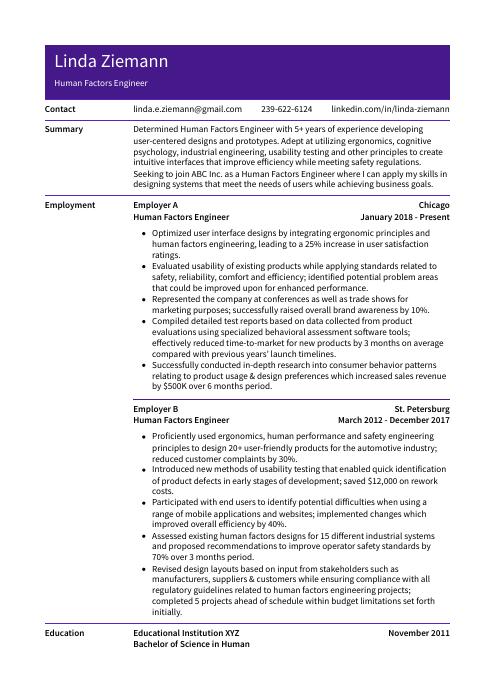 Pika
Pika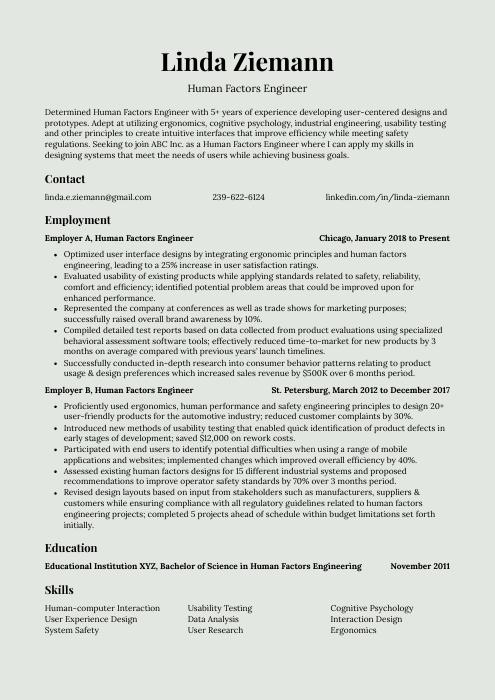 Saola
Saola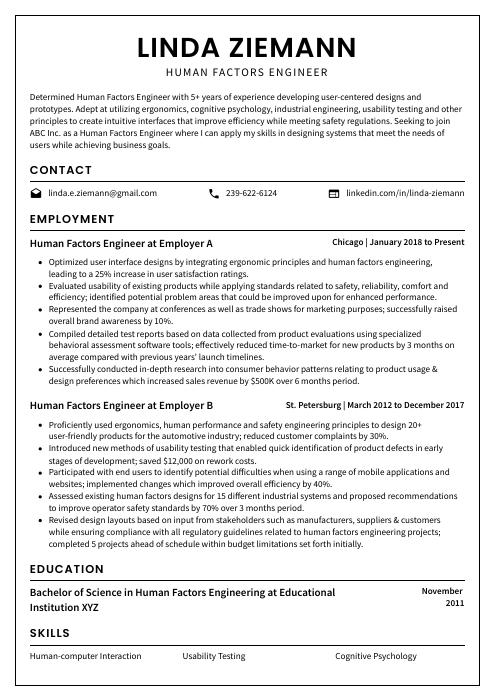 Cormorant
Cormorant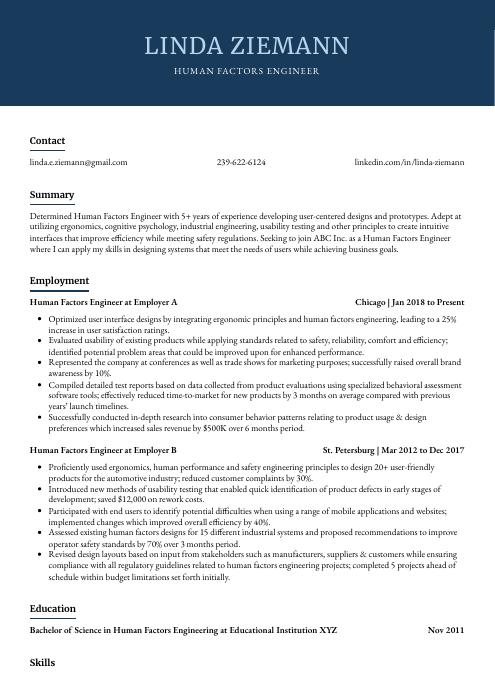 Bonobo
Bonobo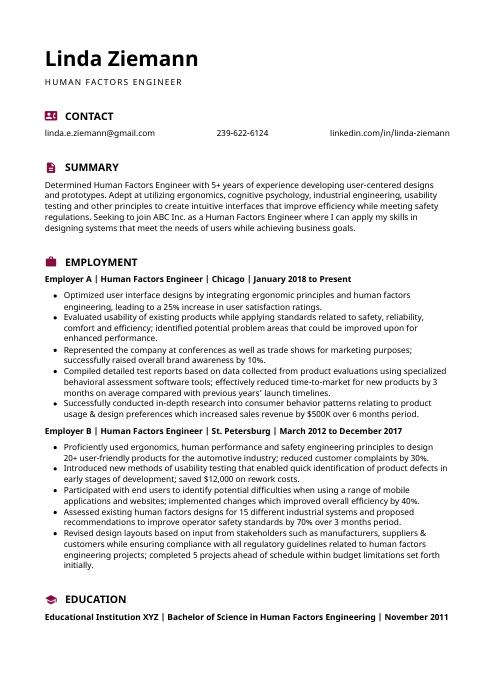 Hoopoe
Hoopoe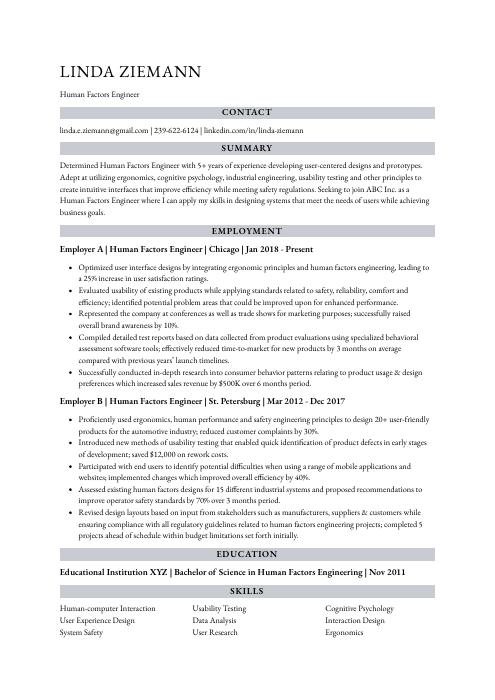 Numbat
Numbat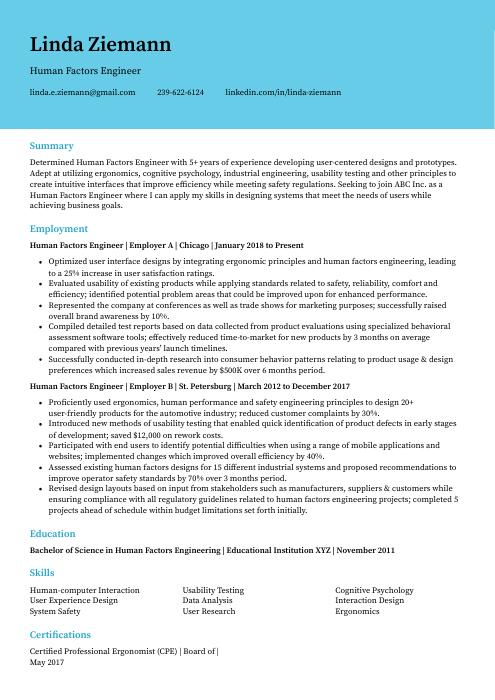 Dugong
Dugong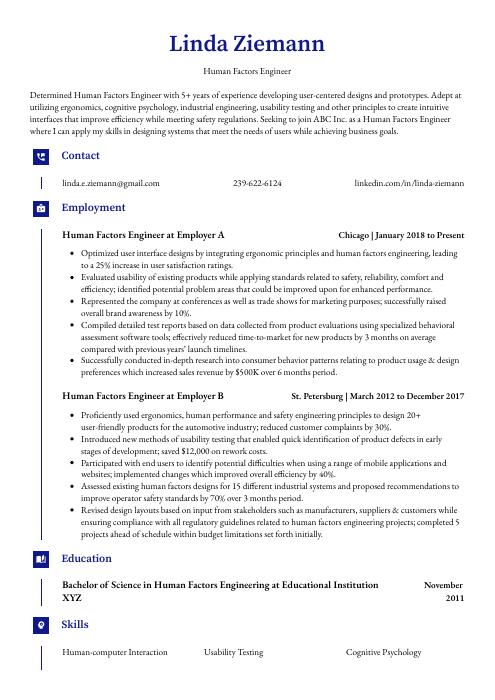 Gharial
Gharial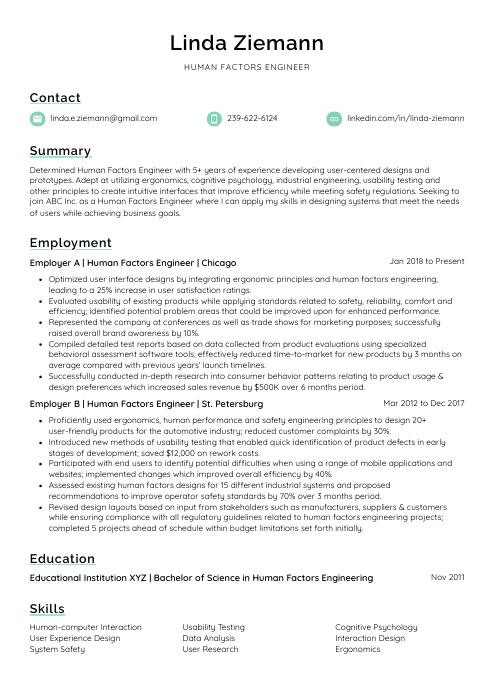 Lorikeet
Lorikeet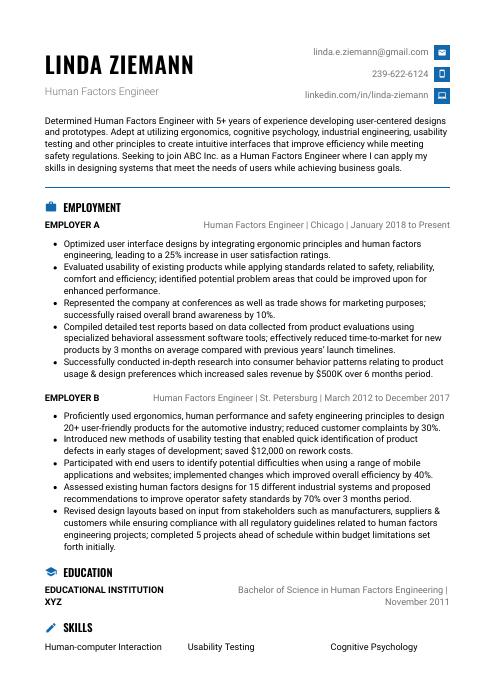 Echidna
Echidna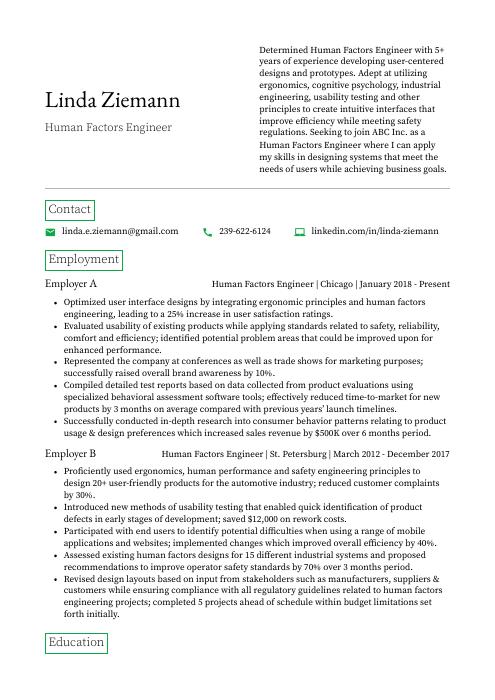 Quokka
Quokka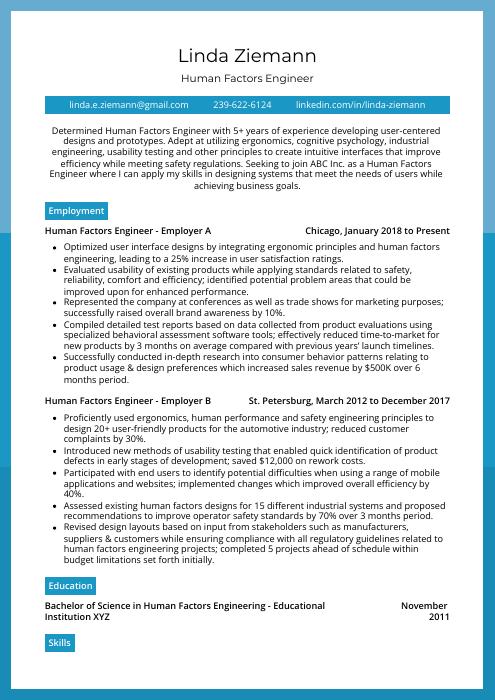 Rhea
Rhea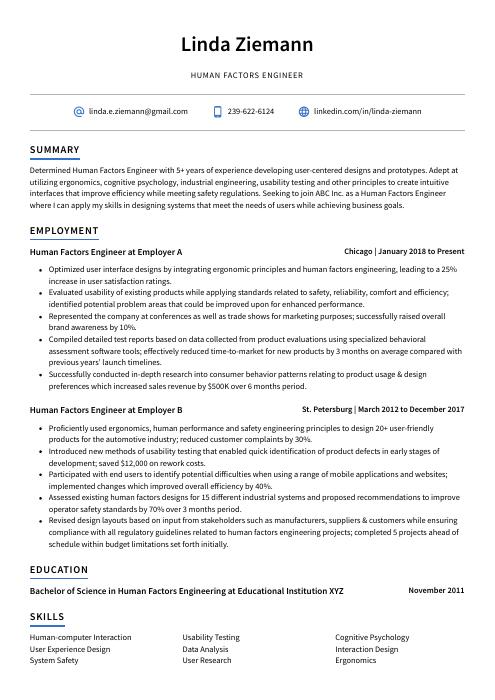 Axolotl
Axolotl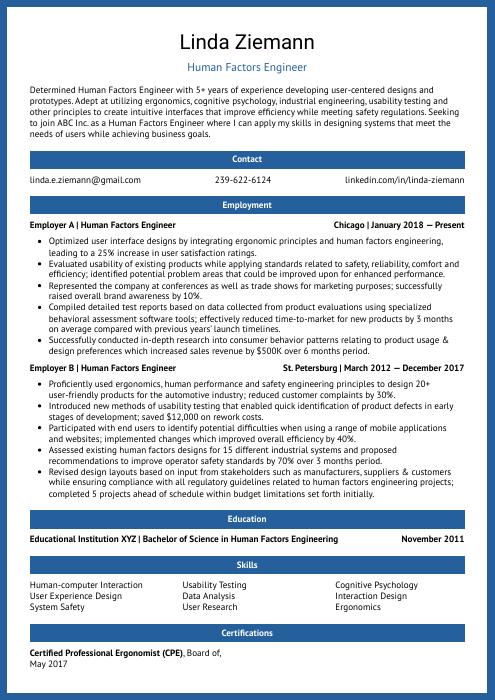 Ocelot
Ocelot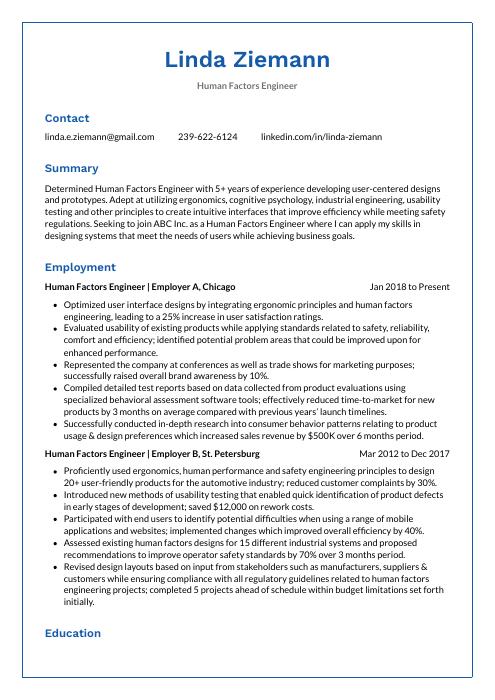 Markhor
Markhor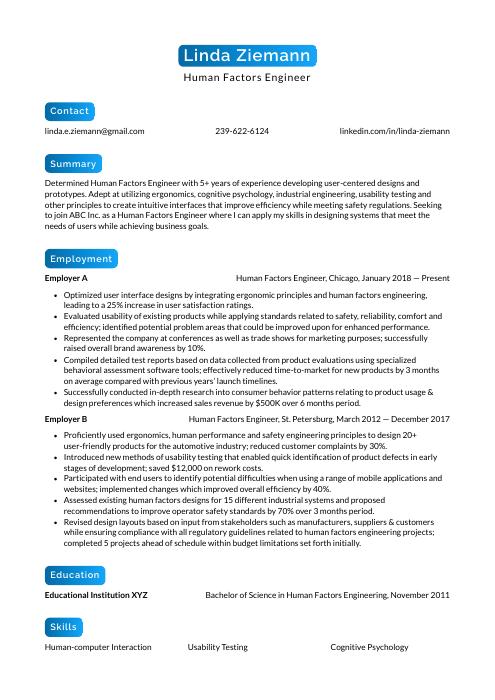 Kinkajou
Kinkajou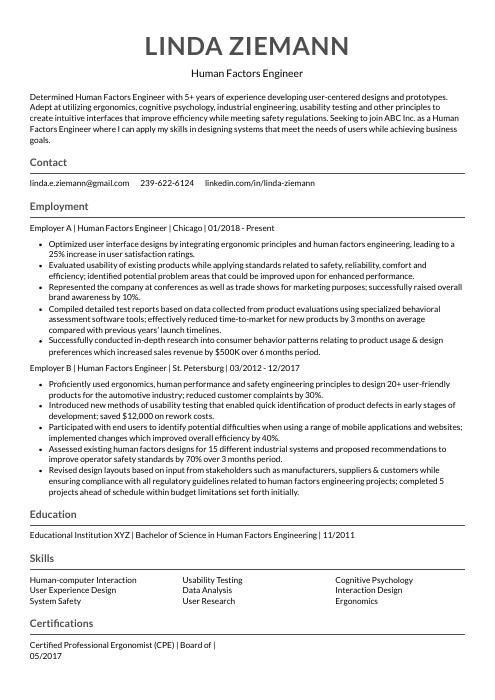 Indri
Indri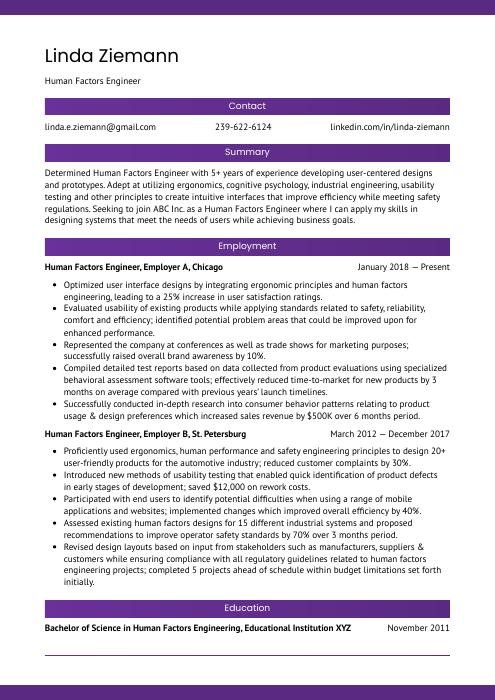 Jerboa
Jerboa Rezjumei
Rezjumei
